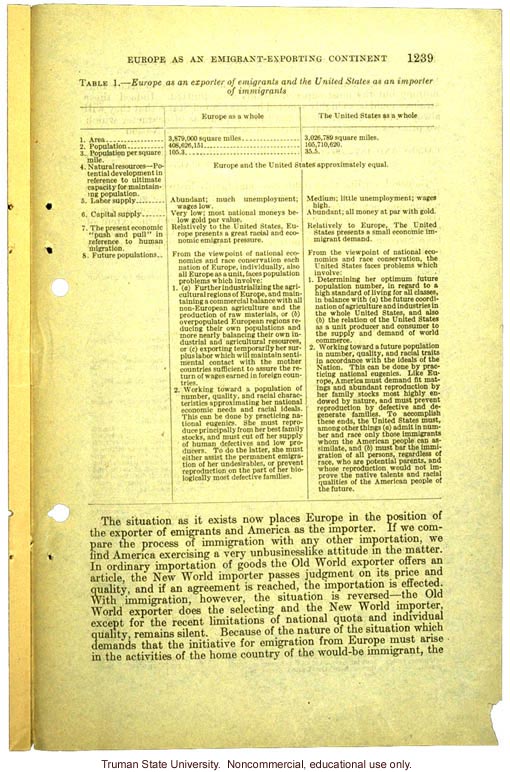(SUE: Note I was unable to view this image in "detail" online - questionable lettering appears in brackets)
Europe as an Emigrant-Exporting Continent 1239
[tabular material]
Table 1. - Europe as an exporter of emigrants and the United States as an importer of immigrants
[hairline score]
&Europe as a whole&The United States as a whole
[hairline score][NOTE: vertical lines appear between columns]
1. Area...&3,879,000 square miles...&3,028,789 square miles.
2. Population...&[408,626,154]...&[166,710,620].
3. Population per square mile.&&
4. Natural resources - Potential development in reference to ultimate capacity for maintaining population.&Europe and the United States approximately equal.
5. Labor supply...&Abundant; much unemployment; wages low.&Medium; little unemployment; wages high.
6. Capital supply...&Very low; most national moneys below gold per value.&Abundant; all money at par with gold.
7. The present economic "push and pull" in reference to human migration.&Relatively to the United States, Europe presents a great racial and economic emigrant pressure.&Relatively to Europe, The United States presents a small economic immigrant demand.
8. Future populations..&From the viewpoint of national economics and race conservation each nation of Europe, individually, also all Europe as a unit, faces a population problems which involve:
1 (a) Further industrializing the agricultural regions of Europe, and maintaining a commercial balance with all non-European agriculture and the production of raw materials, or (b) overpopulated European regions reducing their own populations and more nearly balancing their own industrial and agricultural resources, or (c) exporting temporarily her surplus labor which will maintain sentimental contact with the mother countries sufficient to assure the return of wages earned in foreign countries.
2 Working toward a population of number, quality, and racial characteristics approximating her national economic needs and racial ideals. This can be done by practicing national eugenics. She must reproduce principally from her best family stocks, and must cut off her supply of human defectives and low producers. To do the latter, she must either assist the permanent emigration of her undesirables, or prevent reproduction on the part of her biologically most defective families. &From the viewpoint of national economics and race conservation, the United States faces problems which involve:
1. Determining her optimum future population number, in regard to a high standard of living for all classes, in balance with (a) the future coordination of agriculture and industries in the whole United States, and also (b) the relation of the United States as a unit producer and consumer to the supply and demand of world commerce.
2. Working toward a future population in number, quality, and racial traits in accordance with the ideals of the Nation. This can be done by practicing national eugenics. Like Europe, America must demand fit matings and abundant reproduction by her family stocks most highly endowed by nature, and must prevent reproduction by defective and degenerate families. To accomplish these ends, the United States must, among other things (a) admit in number and race only those immigrants whom the American people can assimilate, and (b) must bar the immigration of all persons, regardless of race, who are potential parents, and whose reproduction would not improve the native talents and racial qualities of the American people of the future.
[hairline score]
[end tabular material]
The situation as it exists now places Europe in the position of the exporter of emigrants and America as the importer. If we compare the process of immigration with any other importation, we find America exercising a very unbusinesslike attitude in the matter. In ordinary importation of goods the Old World exporter offers an article, the New World importer passes judgment on its price and quality, and if an agreement is reached, the importation is effected. With immigration, however, the situation is reversed - the Old World exporter does the selecting and the New World importer, except for the recent limitations of national quota and individual quality, remains silent. Because of the nature of the situation which demands that the initiative for emigration from Europe must arise in the activities of the home country of the would-be immigrant, the


